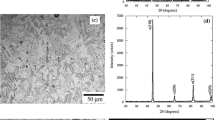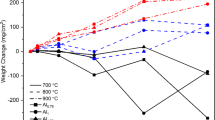Abstract
Various Ni-Si-Cr-B brazing alloys with a similar boron content (3 wt%) are investigated. Alloy compositions cover a section of the quaternary phase diagram that connects BNi-3 to BNi-9 ternary alloys for industrial use. Samples were melted and solidified at low cooling rate (1 K/min) under secondary vacuum to minimize oxidation and the metastable phase formation. Transformation temperatures, microstructures, and chemical analyses are reported. Experimental conditions were found to play a significant role on the accuracy of obtained data. Thermodynamic data were collected upon heating. Before analyzing quaternary alloys, the results of investigated ternary alloys were compared with the literature and discussed.
















Similar content being viewed by others
References
Peaslee RL (2003) Brazing footprints. s.l.: Wall Colmonoy Corporation, pp. 196–198. ISBN: 0–9724479–0-3, S
American Welding Society Technical Activities Committee (2011) Specification for filler metals for brazing and braze welding. American Welding Society Doral, Florida. isbn:978-0-87171-790-0
Ohsasa K, Shinmura T, Narita T (1999) Numerical modeling of the transient liquid phase bonding process of Ni using Ni-B-Cr ternary filler metal. Journal of Phase Equilibria 20(3):199–206
Aluru R, Gale WF, Chitti SV, Sofyan N, Love RD, Fergus JW (2008) Transient liquid phase bonding of dissimilar nickel base superalloys—wettability, microstructure and mechanical properties. Mater Sci Technol 24(5):517–528
Ruiz-Vargas J, Siredey-Schwaller N, Gey N, Bocher P, Hazotte A (2013) Microstructure development during isothermal brazing of Ni/BNi-2 couples. J Mater Process Technol 213:20–29
Schuster JC, Du Y (2000) Experimental investigation and thermodynamic modeling of the Cr-Ni-Si system. Metall Mater Trans A 31A:1795–1803
Lebrun N, Perrot P, Serbruyns A, Tedenac JC (2010) Boron–nickel–silicon in refractory metal systems. Springer, Berlin Heidelberg, pp 133–152
Omori S, Hashimoto Y, Shoji K, Hidaka K, Kohira Y (1972) Liquidus surfaces of ternary Ni-B-Si alloys for use as infiltrants. (in Japanese), J Japan Soc Powder Met 18(8):316–320
Jansson B, Agren J (1984) A thermochemical assessment of liquid-solid equilibria in nickel-rich Ni-Si-B alloys. Mater Sci Eng 63:51–60
Lebaili S, Hamar-Thibault S (1987) Equilibres liquide-solide dans le système Ni-B-Si dans la région riche en nickel. Acta Metall 35:701–710
Tokunaga T, Nishio K, Ohtani H, Hasebe M (2003) Phase equilibria in the Ni–Si–B system. Mater Trans 44(9):1651–1654
Bondar A (2006) Boron–chromium–nickel, Landolt-Boernstein numerical data and functional relationships. Science and Technology (New Series). Group IV: Physical Chemistry, 11, 153–167. Ed: W. Springer, Martissen
Campbell CE, Kattner UR (2002) Assessment of the Cr-B system and extrapolation to the Ni-Al-Cr-B quaternary system. Calphad 26(3):477–490
Lugscheider E, Knotek O, Reimann H (1974) The ternary system Nickel-Chrom-Bor (in German). Monatsh Chem 105(1):80–90
Omori S, Koyama K, Hashimoto Y, Yamada K (1985) Liquidus surface of B-Cr-Ni system (in Japanese). J Japan Inst Met 49(11):935–939
Ruiz-Vargas J, Siredey-Schwaller N, Noyrez P, Mathieu S, Bocher P, Gey N (2014) Potential and limitations of microanalysis SEM techniques to characterize borides in brazed Ni-based superalloys. Mater Charact 94:46–57
Acknowledgments
The authors thank Etablissements Chpolansky, Marcoussis, France, which kindly provided the certified commercial brazing alloys. Dr. J. Zollinger calculated the equilibrium ternary alloy phase diagrams with Thermo-Calc® and the TTNi7 database. M. Bertrand, master student, also contributed to this study. Finally Dr. L. Peltier and P. Charbonnier realized a secondary vacuum furnace which allowed melting of these alloys. The authors thank NSERC and CRIAQ for their indirect financial support on related projects.
Author information
Authors and Affiliations
Corresponding author
Additional information
Recommended for publication by Commission XVII - Brazing, Soldering and Diffusion Bonding
Rights and permissions
About this article
Cite this article
Siredey-Schwaller, N., Hamel-Akré, J., Peltier, L. et al. Solidification sequence of Ni-Si-Cr ~3wt% B brazing alloys. Weld World 61, 1253–1265 (2017). https://doi.org/10.1007/s40194-017-0503-4
Received:
Accepted:
Published:
Issue Date:
DOI: https://doi.org/10.1007/s40194-017-0503-4




